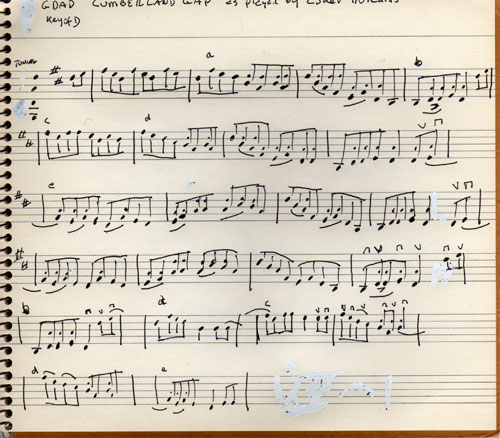Esker Hutchins (FRC107)
by Jody Stecher (Fiddler Magazine)
Esker Hutchins. What a great name; sounds like someone taking a bite out of a fiddle. His music did have a lot of bite and crunch actually, and when he had a good band behind him, Esker Hutchins of Surry County, North Carolina played some of the most exciting music I’ve ever heard. Playing solo he was more relaxed but still he had that powerful and incisive bowing arm. He was a significant fiddle inspiration to the well-known fiddler Benton Flippin, also of Surry County; Hutchins apparently was Flippin’s direct mentor as well. Hutchins’ own influences were myriad and included local celebrity Frank Jenkins and the “radio fiddling” of Arthur Smith. His repertoire included local tunes like “Breaking Up Christmas,” radio tunes like “Black Mountain Rag” and Arthur Smithユs “Peacock Rag,” bluegrass songs like “Cabin In Caroline,” and universal old time favorites “Forked Deer” and “Mississippi Sawyer.” In this workshop (CROSS-TUNING WORKSHOP Part Thirty-Eight: GDAD) I’ve transcribed a tune in the key of D that may be an unusual version of a tune in the latter category, one that Hutchins recorded for Ray Alden and Dave Spilkia c. 1971 and which was released on Field Recorders’ Collective CD FRC107 as “Unnamed Fiddle Tune #2.” I emailed Ray to see if anyone has come up with a title and he forwarded me some comments by fiddler Dave Spilkia, who suggested that it was a variant of Cumberland Gap. I think he’s probably right.
Cumberland Gap, the place, is the ancient entryway to the west, a natural break in the Appalachian mountains at the convergence of what is now Virginia, Tennessee and Kentucky, through which ol’ Dan’l Boone led many a settler into “Kaintuck.” “Cumberland Gap” the tune has many variations and settings, both crooked and foursquare, and is played in a number of keys, most usually G or D. I sometimes play it in the key of F in standard tuning, as the sound is so pleasing there and the fingering very natural as well. Esker Hutchins plays it in D with his first string tuned down a step to be an octave above the third string. The tune would play well with bass string tuned up to A but on this recording it sounds like it hasn’t been tuned up from standard; one can hear an unbowed G ring out from time to time, especially at the end of phrases.
The high part has an Arthur Smith sound to it, but I don’t think I ever heard it played this way by Smith, who regularly played Cumberland Gap in G and with different melodic features. Here Hutchins is tuned a half step below standard pitch but I’ve notated as in the key of D, which is how Hutchins is fingering the tune.
Each time through the tune Hutchins makes small changes in the bowing or in the melody. I’ve notated some of these and I appreciate and am delighted with how effective these variations are. Just by adding or removing a slur or by applying one rhythmic device in several places, his music gains in variety and pizzazz. For instance check out how he changes a phrase of four eighth notes of different pitches to a quarter and two eighths on one pitch ( E on the first string or B on the second string) or a quarter on one pitch followed by two eighths on a neighboring tone (the open D string followed by E on the same string) and how he integrates that into the melodic and rhythmic flow.
